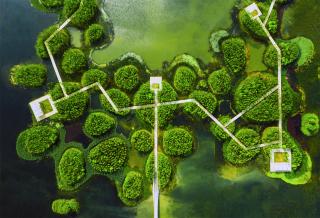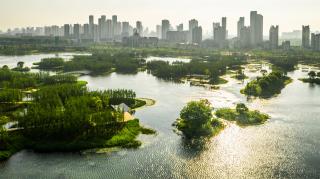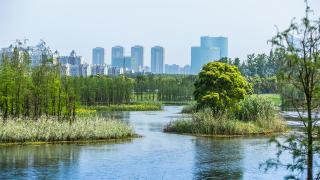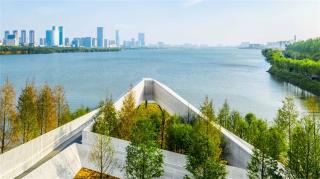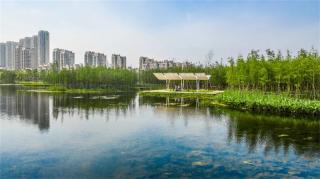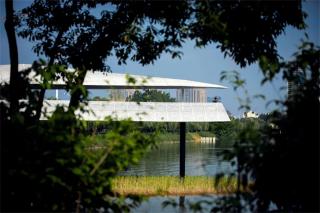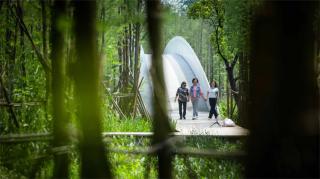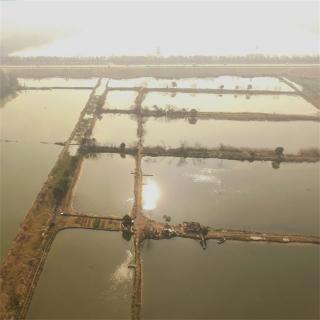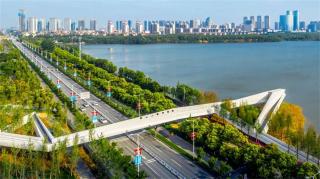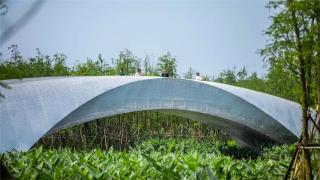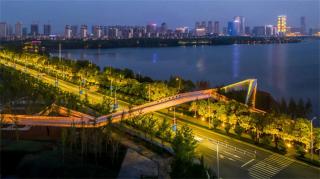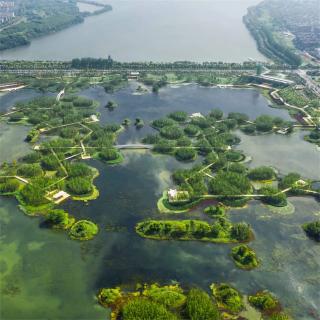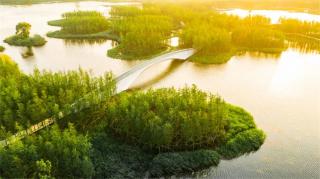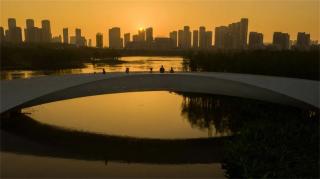漂浮的森林:南昌市魚(yú)尾洲公園
A Floating Forest: Fish Tail Park in Nanchang City
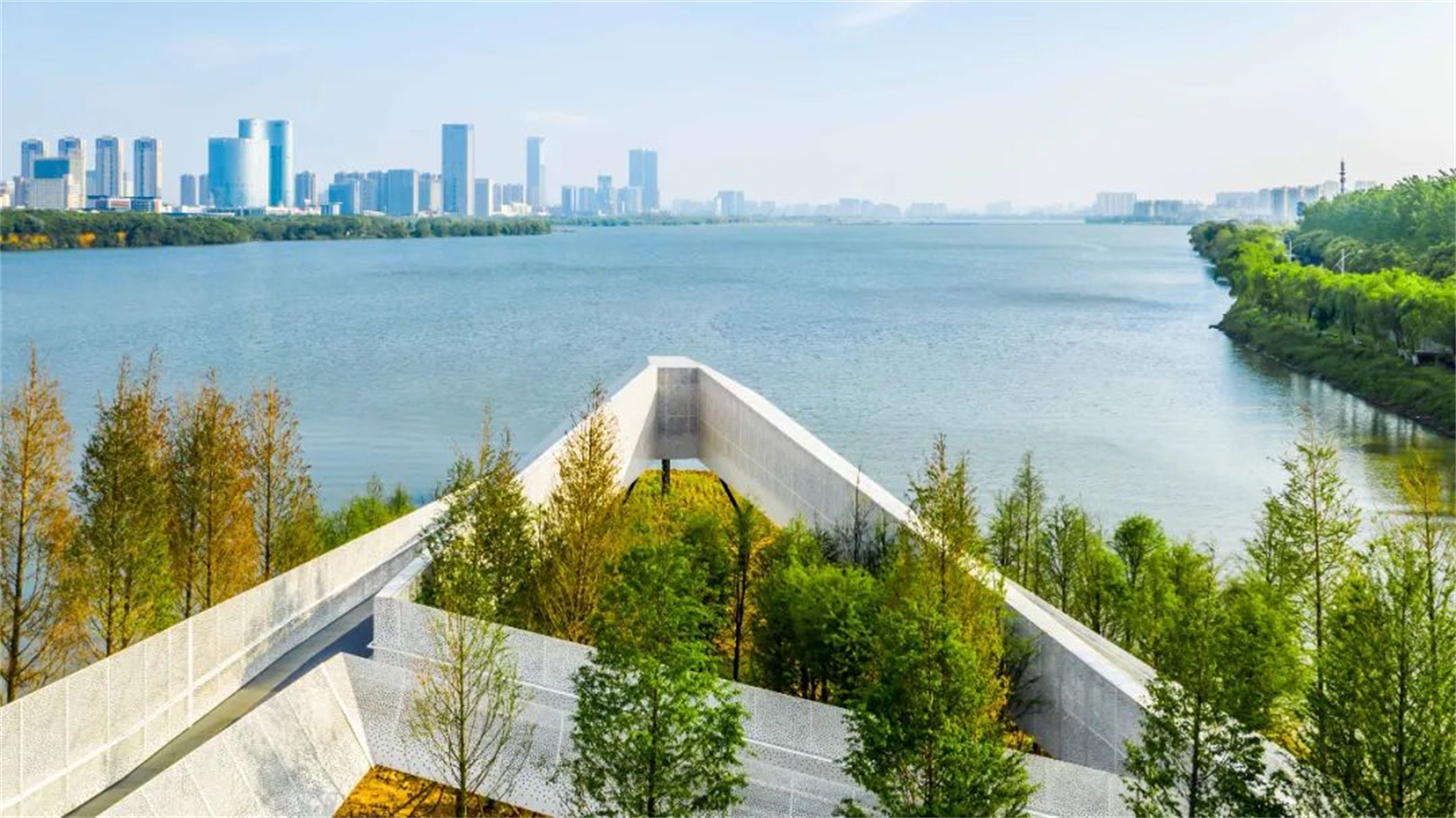
南昌城始建于公元前202年
“物華天寶、人杰地靈”
今日�����,南昌是江西省省會(huì),
是江西省政治����、經(jīng)濟(jì)、文化�、科技中心、
國(guó)家航空��、光電產(chǎn)業(yè)基地��,世界級(jí)光伏產(chǎn)業(yè)基地�����。
01 項(xiàng)目說(shuō)明
A Floating Forest: Fish Tail Park in Nanchang City
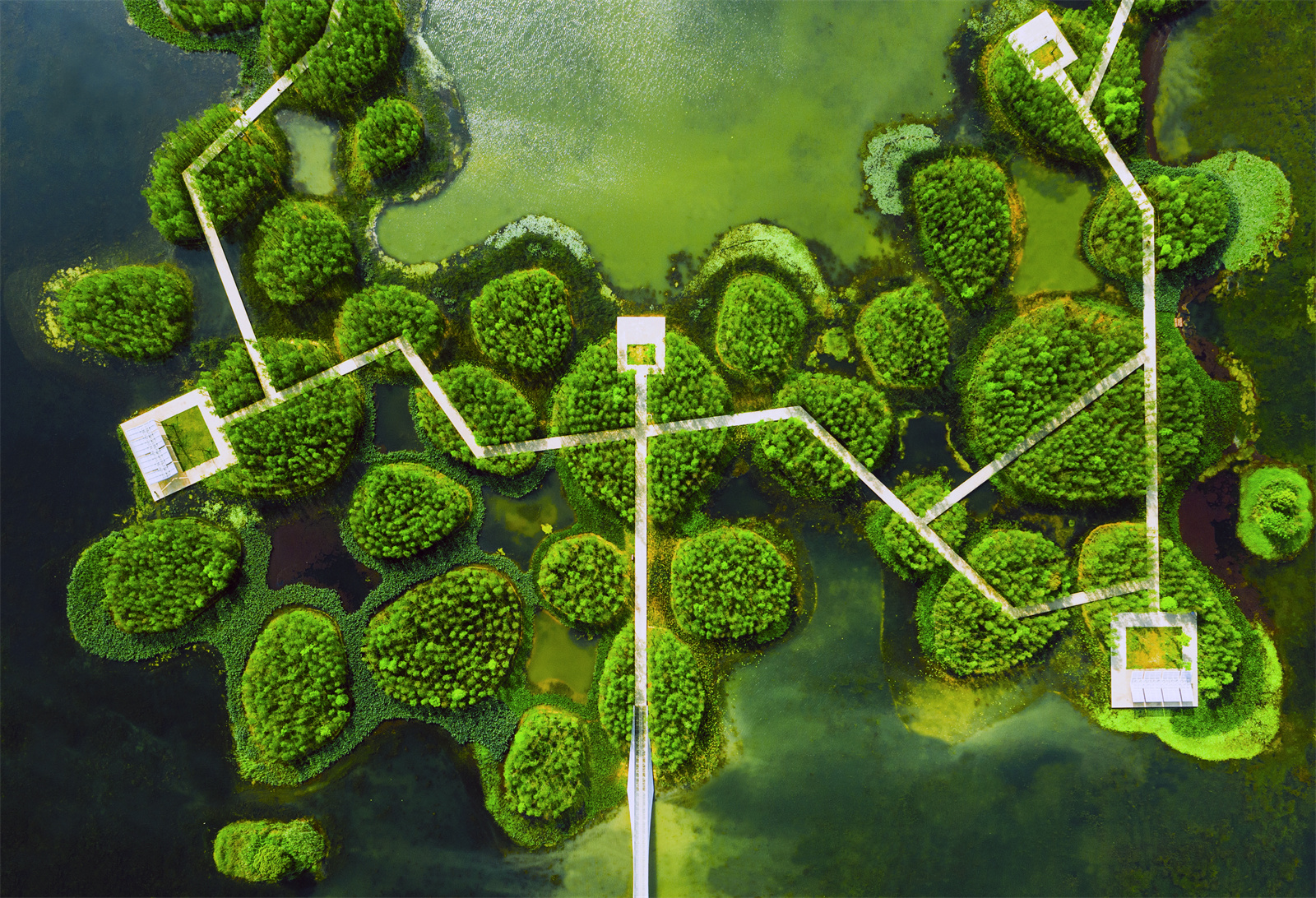
在中國(guó)中東部長(zhǎng)江洪泛平原的南昌市�,我們將一片面積126英畝、嚴(yán)重受污染的水產(chǎn)養(yǎng)殖塘改造成了一片夢(mèng)幻般的漂浮森林��。它調(diào)節(jié)著雨水���,為野生動(dòng)物提供了棲息地��,為城市補(bǔ)充了一系列的公共空間�����,并為當(dāng)?shù)鼐用裉峁┝艘环N與自然聯(lián)系的新方式��。所有這些都賦予了城市新區(qū)獨(dú)特的身份�����,并促進(jìn)了周邊地區(qū)的城市發(fā)展�����。魚(yú)尾洲公園為季風(fēng)或氣候多變的地區(qū)提供了一個(gè)可復(fù)制的城市自然設(shè)計(jì)的模型��,可以應(yīng)對(duì)洪水����、棲息地恢復(fù)和城市公共休閑需求等多重挑戰(zhàn)。該項(xiàng)目是一次景觀設(shè)計(jì)師為城市賦予更大韌性的嘗試��,旨在表明城市空間不僅可以為人類(lèi)��,也可以為自然災(zāi)害的影響(如季風(fēng)風(fēng)暴)在城市中開(kāi)辟新的空間����,從而推動(dòng)關(guān)鍵的自然與人類(lèi)和諧共處的過(guò)程。
In the city of Nanchang, within the Yangtze River flood plain in east-central China, we transformed a 126-acre badly abused landscape into a dreamlike floating forest that regulates storm water, provides habitat for wildlife, offers an array of recreational opportunities and gives local residents a new way to connect with nature. All of this lent a unique identity to the New District and served as a catalyst for urban development in the surrounding area. Fish Tail Park offers a replicable model of designed urban nature for regions with monsoon or variable climates that can address the multiple challenges of floods, habitat restoration and recreational demands. The project is part of a larger effort by the landscape architect to show that it is possible to open up new space in cities not just for people, but also for nature and for the powerful forces, like monsoon storms, that drive critical natural processes.
▼設(shè)計(jì)前
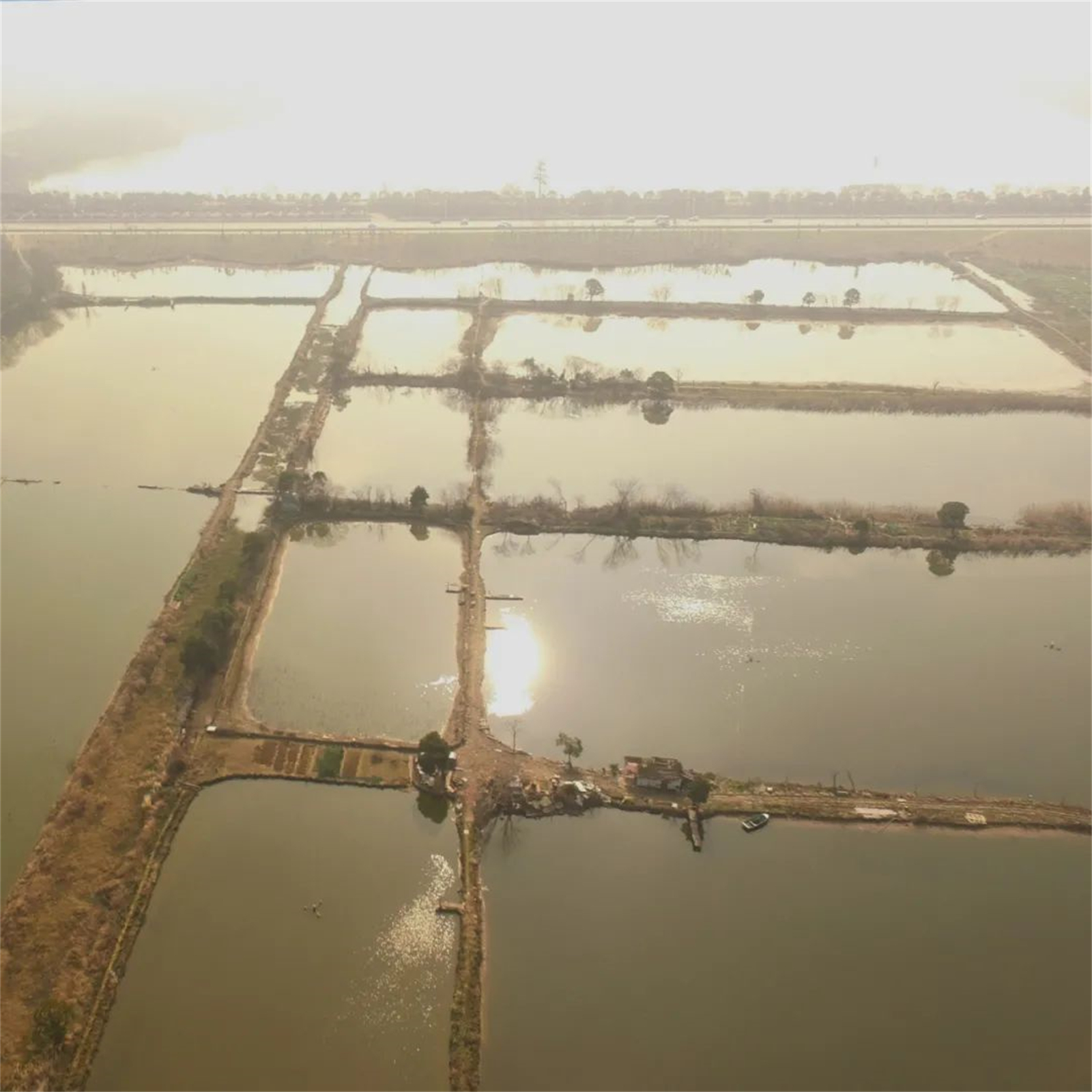
▼設(shè)計(jì)后
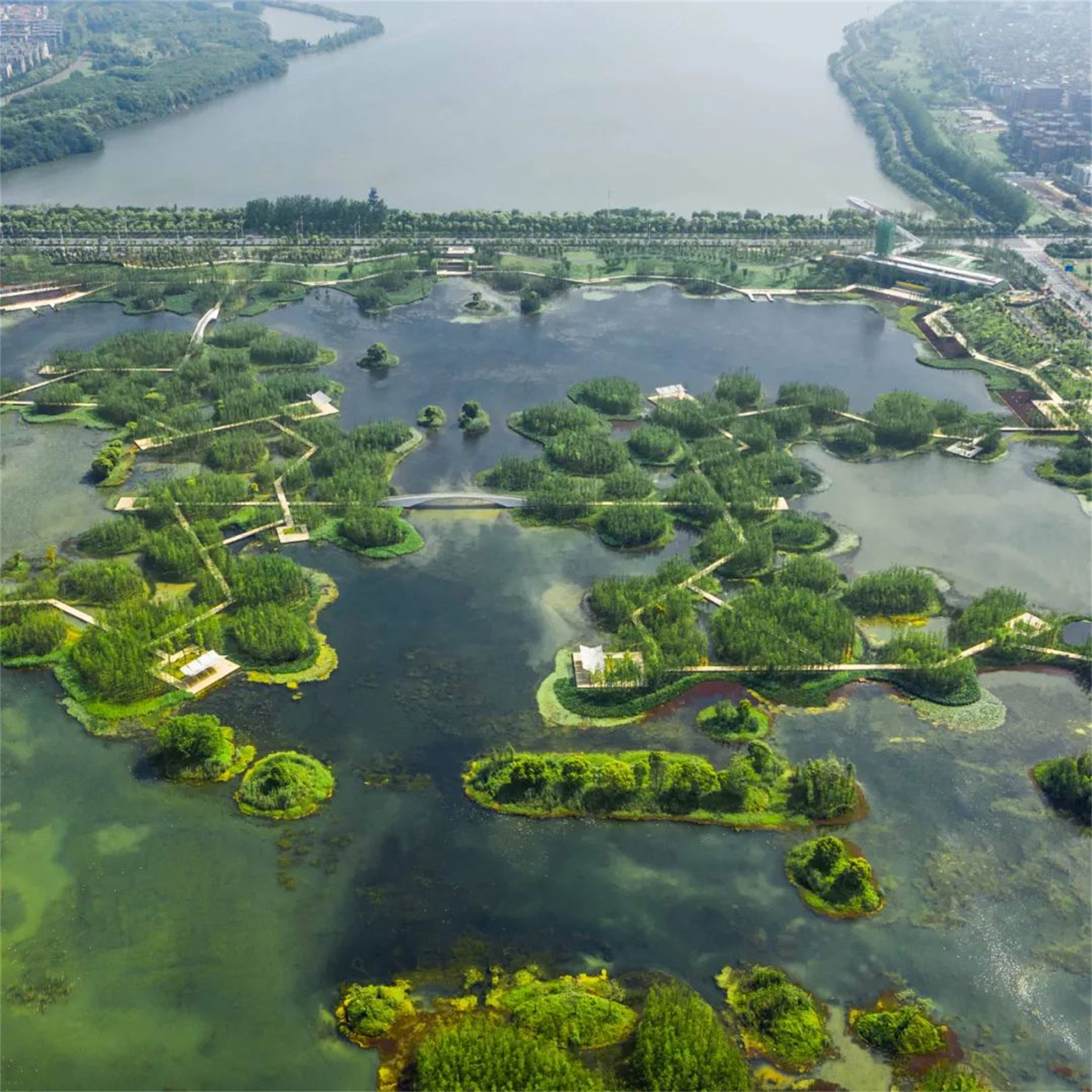
02 現(xiàn)場(chǎng)挑戰(zhàn)和目標(biāo)
Site Challenges and Objectives
南昌是江西省的省會(huì)城市�����,人口超過(guò)620萬(wàn)��。她是長(zhǎng)江中游最大的城市之一���,位于中國(guó)最大的淡水湖鄱陽(yáng)湖的西岸�����。雨季期間����,區(qū)域洪水和城市內(nèi)澇一直是該市面臨的長(zhǎng)期挑戰(zhàn)��。近年來(lái)����,由于氣候變化和城市快速發(fā)展對(duì)該地區(qū)湖泊和濕地的消極影響,該問(wèn)題一直在惡化�,并大大降低了自然湖泊和濕地的調(diào)水能力����。與此同時(shí)��,越來(lái)越多的城市徑流對(duì)地表水造成了日益嚴(yán)重的污染�,影響了居民、候鳥(niǎo)和其他野生動(dòng)物的生活和棲息�。大量新的公共空間在這背景下正在設(shè)計(jì)和建造,以滿(mǎn)足不斷增長(zhǎng)的人口的休閑需求���。在這過(guò)程中���,景觀設(shè)計(jì)和城市化面臨的最大挑戰(zhàn)和機(jī)遇,是如何以低成本����、可大規(guī)模復(fù)制的方式,用綜合�、集成、高效的解決方案�����,以解決所有問(wèn)題。
該項(xiàng)目占地51公頃(126英畝)��,是從自然濕地中開(kāi)墾出來(lái)的養(yǎng)魚(yú)場(chǎng)�,其中大約30%的土地是用于傾倒周?chē)l(fā)電廠廢料的粉煤灰填埋場(chǎng)�����。由于粉煤灰的填埋和過(guò)度魚(yú)飼料的使用��,使城市徑流和地表水都受到了嚴(yán)重的污染���。而項(xiàng)目周?chē)膮^(qū)域又計(jì)劃和進(jìn)行著密集的城市開(kāi)發(fā)���,因此當(dāng)?shù)卣烷_(kāi)發(fā)商都希望利用該公園作為建設(shè)整個(gè)新區(qū)的催化劑。景觀設(shè)計(jì)師將場(chǎng)地面臨的挑戰(zhàn)視為機(jī)遇���,決心創(chuàng)造一個(gè)有彈性的�、城市自然庇護(hù)所�。該公園將提供多種生態(tài)系統(tǒng)服務(wù),包括城市洪水調(diào)節(jié)���、水過(guò)濾凈化����、鳥(niǎo)類(lèi)和其他野生動(dòng)物棲息地,以及市民高質(zhì)量的休閑活動(dòng)公共空間����,并促進(jìn)城市開(kāi)發(fā),為許多快速發(fā)展的季風(fēng)城市和地區(qū)面臨的共同挑戰(zhàn)提供可復(fù)制的模式和范例�����。
Nanchang is the capital city of Jiangxi Province and has a population of over 6.2 million people. It is one of the biggest cities in the middle reach of the Yangzi River and is located on the western shore of Poyang Lake, China’s largest fresh water lake. Flooding and urban inundation during the monsoon season has been a chronic challenge for the city. The problem has been worsening in recent years due to the impacts of climate change and rapid development on lakes and wetlands in the area, which has significantly reduced the natural landscape’s water-regulating capacity. At the same time, surface water has been increasingly polluted by growing amounts of urban runoff, impacting the habitat of resident and migratory birds and other wildlife. New public spaces are being designed and built to fulfill the recreational needs of the growing population, but the biggest challenge — and opportunity — for landscape architecture and urbanism is how to develop integrated, efficient solutions to tackle the full spectrum of issues at low cost and in a manner that can be replicable at large scale.
The site is 51 hectare (126 acre) former fish farm reclaimed from a natural wetland. Roughly 30% of the site is a former dump site for coal ash from power plants around the city. The water is polluted due to the coal ash and overuse of fish feed, as well as urban runoff. The area surrounding the site is slated for dense urban development, and both the local government and the developers hope to use the park as a catalyst to develop the entire New District. Seeing the challenges of the site as an opportunity, the landscape architect resolved to create a resilient, natural urban refuge. The park will provide numerous ecosystem services including urban flood regulation, water filtration, habitat for birds and other wildlife, as well as a public space for recreational activities, while catalyzing urban development and providing a replicable model for the shared challenges that many monsoon cities in fast-developing regions are facing.
▼魚(yú)尾洲與城市
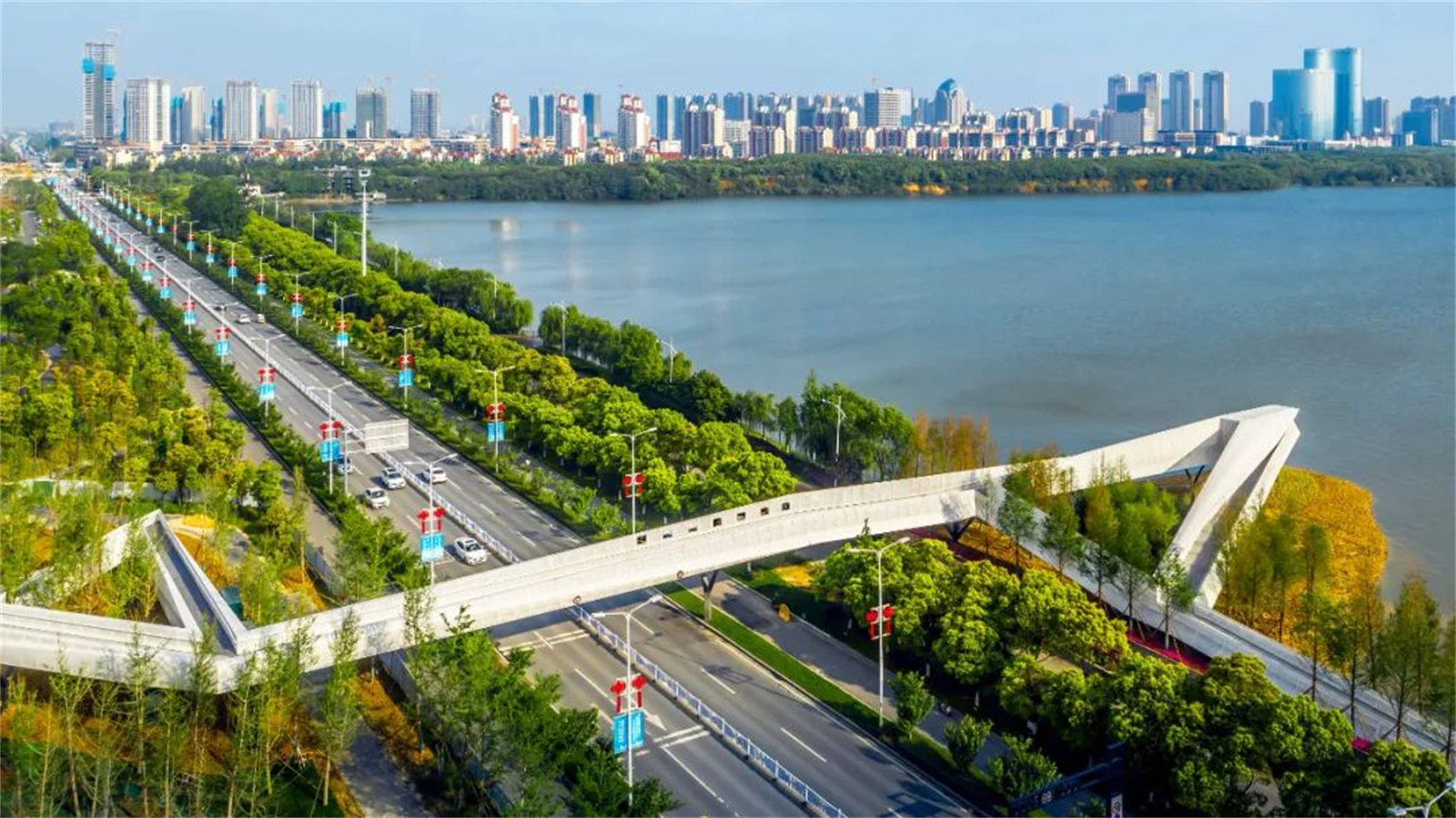
03 設(shè)計(jì)策略:水上森林
Design Strategy: A Forest on the Water
為了應(yīng)對(duì)所有季風(fēng)性城市面臨的共同挑戰(zhàn)和該場(chǎng)地的獨(dú)特挑戰(zhàn)��,我們采用了以下設(shè)計(jì)策略:
To tackle both the common challenges facing all monsoon cities and the unique challenges of this particular site, we pursued the following design strategies:
3.1一個(gè)將垃圾場(chǎng)改造成島鏈的“寶石湖
Transform an Urban Dumping Ground into an Island-Jeweled Lake
受古代沼澤地上耕作的垛田概念���、和Aztec Chinampas簡(jiǎn)單的挖填技術(shù)�����、以及漂浮花園系統(tǒng)的啟發(fā)��,設(shè)計(jì)師將傾倒在現(xiàn)場(chǎng)的粉煤灰回收利用����,并與魚(yú)塘塘基的泥土摻合����,形成了許多小島�。
與此同時(shí)���,一個(gè)能容納水位上升兩米(6.5英尺)的����、可蓄滯100萬(wàn)立方米洪水的湖泊被建成�����。
Inspired by the ancient concept of farming atop marshland, and by simple cut-and-fill techniques such as the Aztec Chinampas, or floating garden system, the coal ash dumped on site was recycled and mixed with dirt from the fish pond dykes to create numerous islets.
At the same time, a lake able to accommodate two meters (6.5 feet) of water-level rise was created, providing the capacity to catch a full 1 million cubic meters of storm water inflow.
▼城市“海綿”
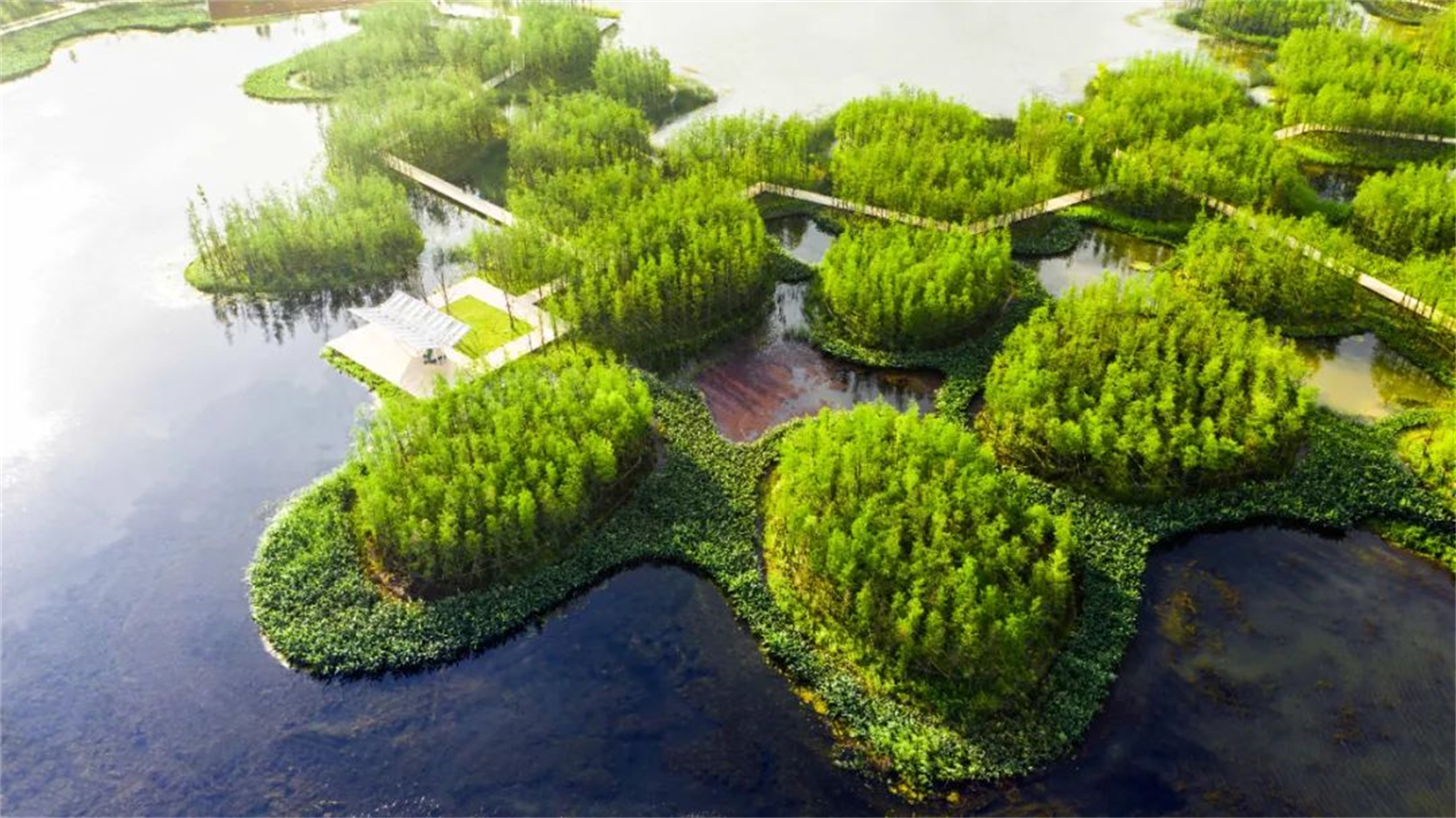
▼雨洪調(diào)蓄
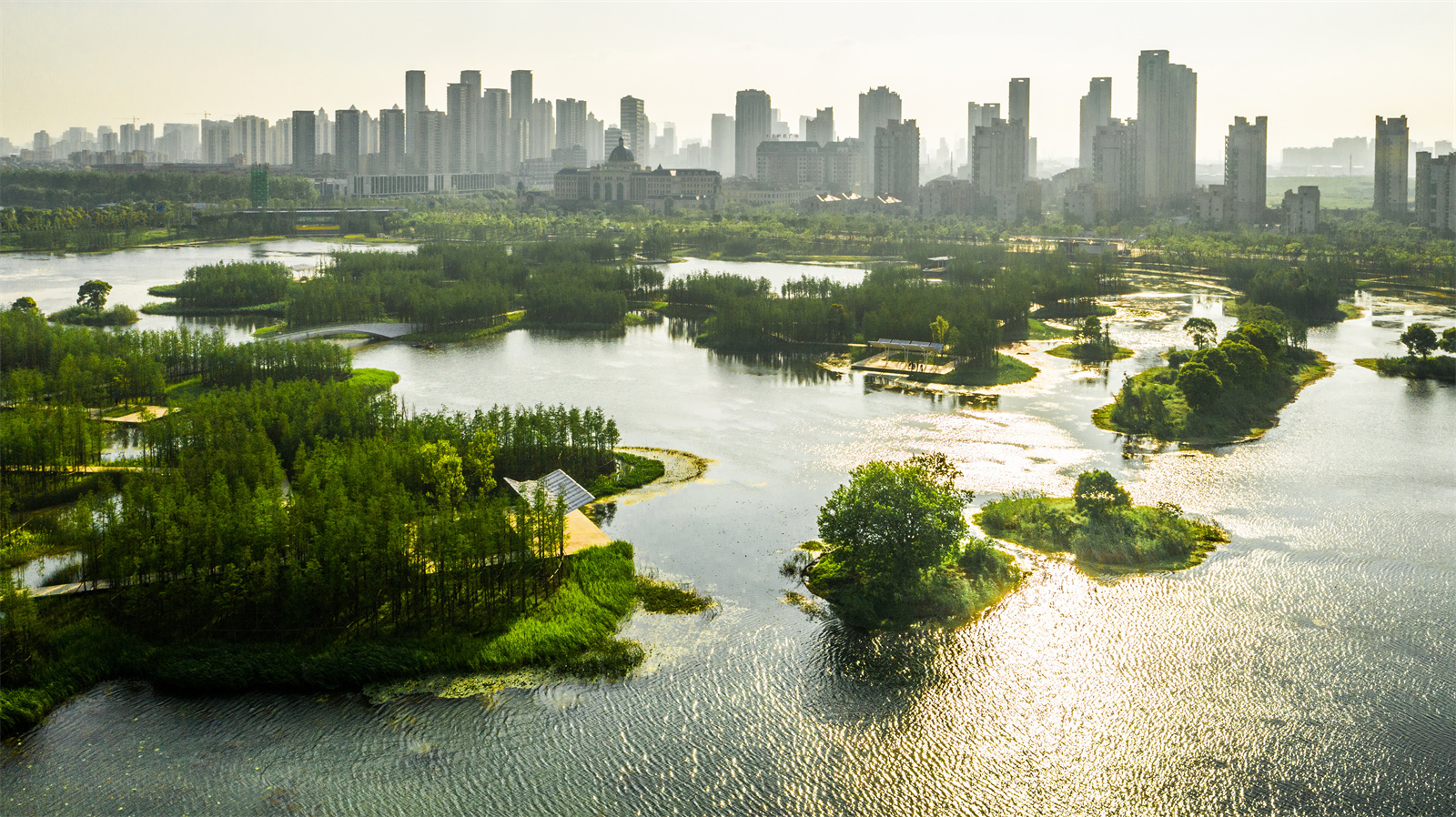
3.2一個(gè)與水共生的森林核心
A Flood-Adapted Forest Is the Park’s Heart
受鄱陽(yáng)湖當(dāng)?shù)丶撅L(fēng)氣候下形成的�、洪泛適應(yīng)性的湖沼濕地啟發(fā)�����,我們選擇了能夠在水位漲落中生存的樹(shù)種��,包括落羽杉���、池杉和水杉���。由于起伏的水位經(jīng)常暴露出貧瘠泥濘的水岸線,因此在水岸線和島嶼邊緣種植了多年生和一年生的濕生植物,并以荷�����、蓮等植物覆蓋了大量湖泊水面形成了濕地的水生生境��。
Inspired by Poyang Lake’s native monsoon-flood-adapted marsh landscape, we selected tree species that are able to survive fluctuating water levels, including Taxodium distichum , Taxodium distichum var. imbricatum and Metasequoia glyptostroboides. Because fluctuating water levels often expose barren muddy shorelines, perennial and annual wetland plants were planted along the shorelines and island edges, and lotus plants provide highly efficient lake cover.
▼雨水凈化
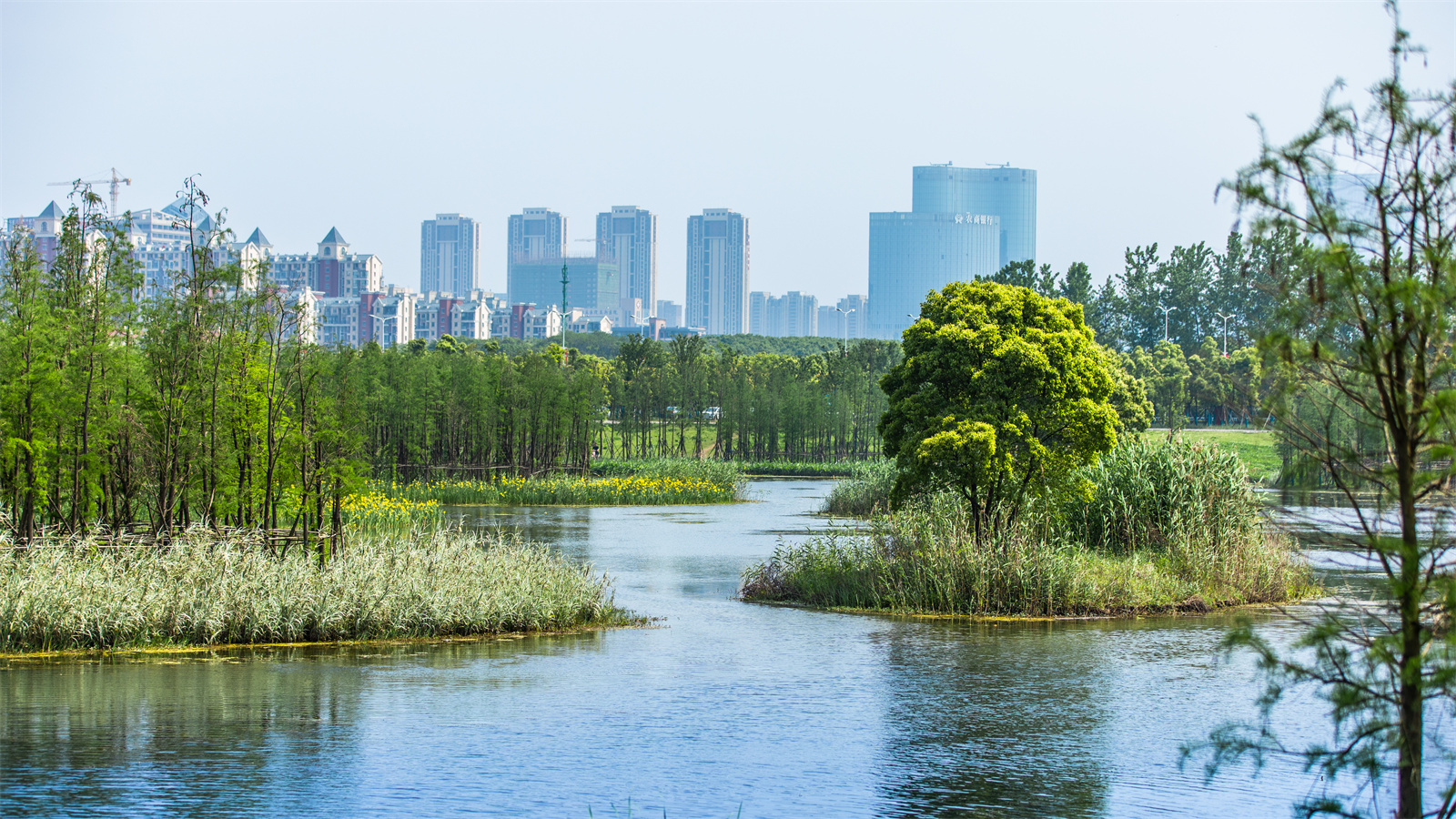
3.3一片城水交錯(cuò)的活力水岸
A Recreational Waterfront at the Edge between City and Nature
項(xiàng)目中部的水上森林在每年的季風(fēng)性汛期期間都會(huì)被淹沒(méi)��,形成的消落帶景觀為市民在高密度的城區(qū)可以沉浸的感受到一片“野性”的沼澤濕地風(fēng)貌�����。與此同時(shí)��,環(huán)湖的濱水區(qū)域可以適應(yīng)20年一遇的洪水淹沒(méi)���,并為市民提供了大量的滿(mǎn)足休閑功能的空間����,其中有自然游樂(lè)場(chǎng)�����、沙灘��、涌泉和草坪。項(xiàng)目周邊則利用了梯田人工濕地過(guò)濾和凈化了城市匯入的地表徑流����。
The central forest on the water, which is submerged during the annual monsoon floods, provides opportunities to explore nature and a “messy,” immersive marsh experience. The waterfront at the periphery of the park, meanwhile, is designed to accommodate 20-year floods and provide a zone that can meet the recreational needs of the local population, and includes natural playgrounds, beaches, fountains and lawns. Terraced constructed wetlands are designed to filter urban runoff.
▼候鳥(niǎo)棲息地
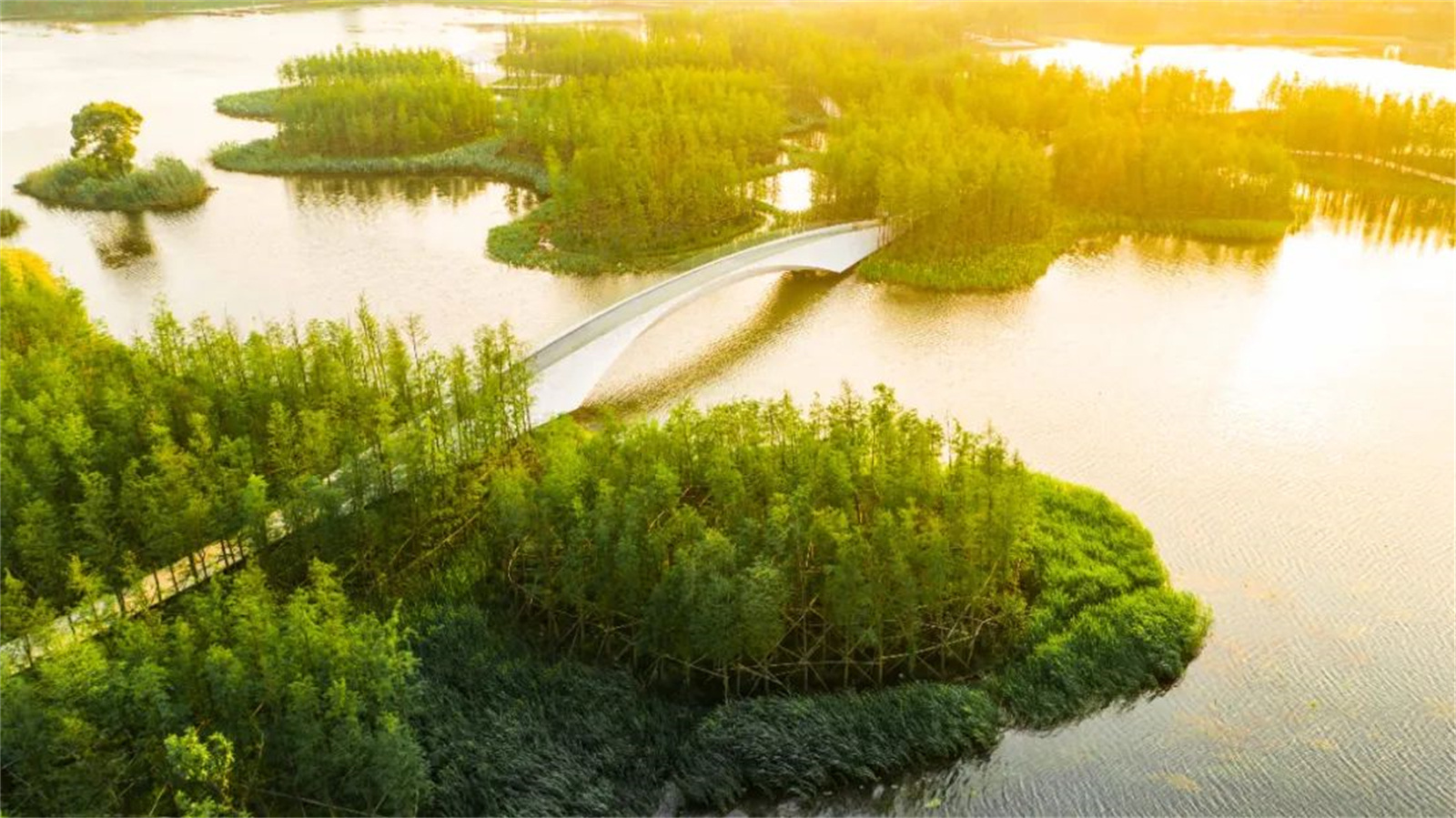
▼棲息地屏障
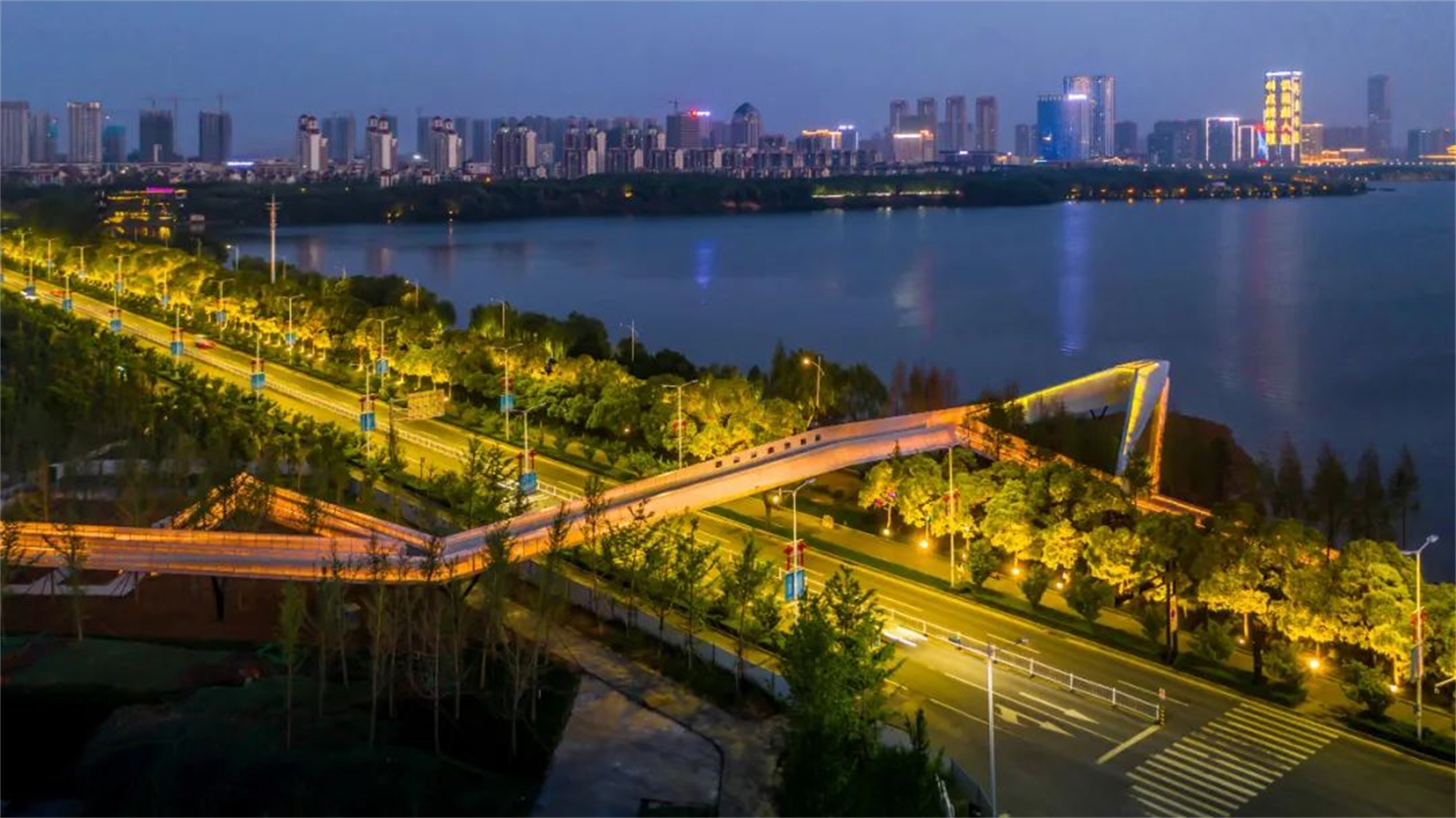
3.4一個(gè)與水交融的濕地秘境
A Flood-Resilient Boardwalk and Spots for Immersive Contact with Nature
公園周邊環(huán)繞了自行車(chē)道和親水步道,環(huán)繞的步行道和平臺(tái)體系為游客提供了多處通往森林島嶼的林蔭通道����,形成了無(wú)數(shù)的探索濕地秘境的空間。親水步道在20年一遇的洪水和年度的季風(fēng)性洪水期間可被淹沒(méi)�����,使?jié)竦孛鼐吃谝荒曛杏袔滋鞎?huì)無(wú)法進(jìn)入�����。雖然環(huán)形人行道位于20年一遇的洪水線之下��,但步道和平臺(tái)皆由預(yù)制混凝土制成���,并架空在地面和水面之上,浸水后可以很容易地清洗干凈��,而秘境中的長(zhǎng)凳也是由耐水淹的鋁材制成的�����。
A bike route and service road follow the park’s periphery. A network of pedestrian paths and platforms surrounds the lake and provides access to the forested isles, offering visitors myriad opportunities to explore. The boardwalk is designed to be submerged during 20-year flood events and annual monsoon floods, which can render the central part of the park inaccessible several days at a time. While the circular pedestrian and bike paths are above the 20-year flood event line, the boardwalk and platforms are made of prefabricated concrete detached from the ground or floating above water and can be easily washed clean after being submerged, as are the benches, which are made of aluminum.
▼構(gòu)筑物
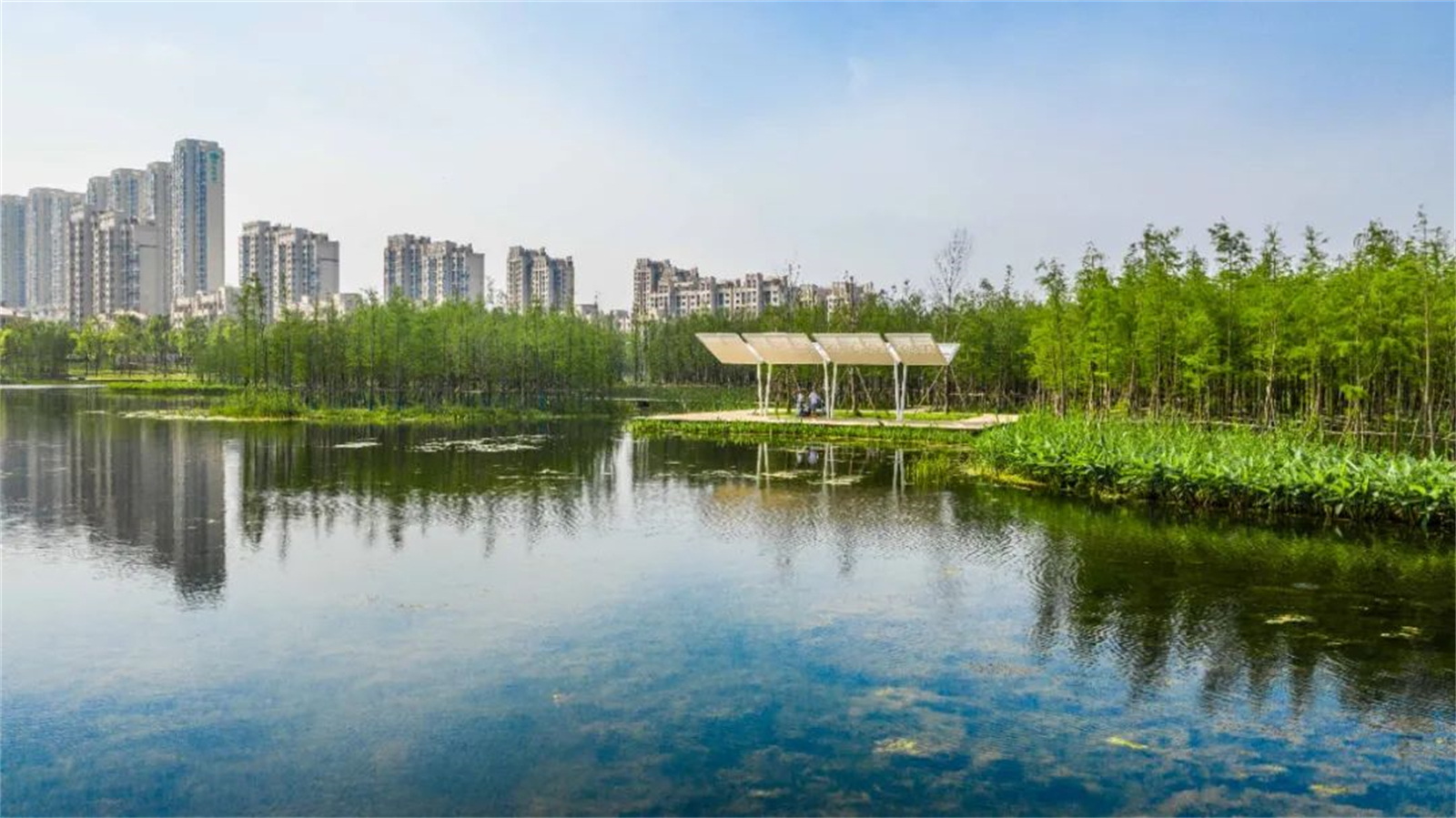
▼城市展示中心
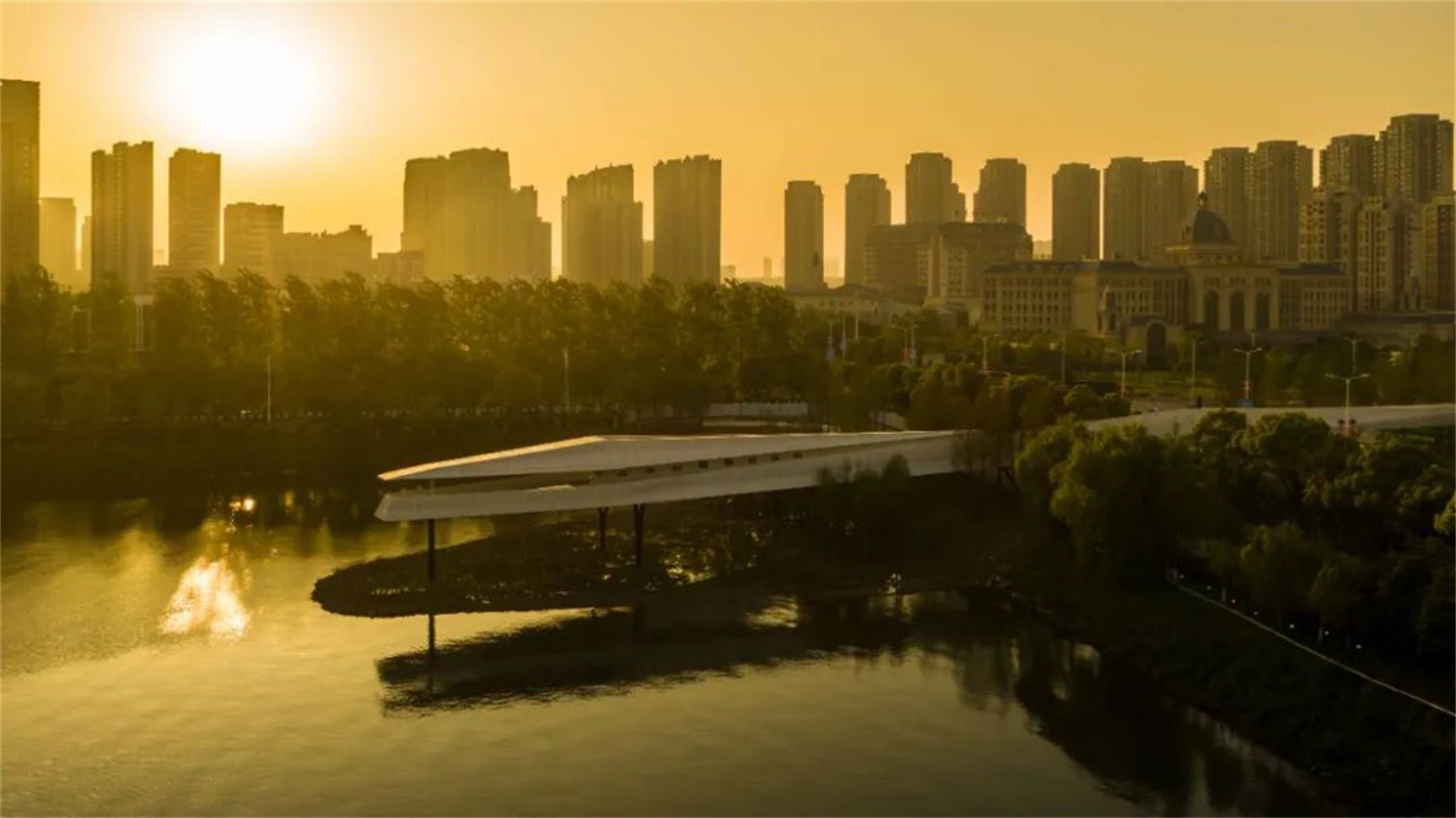
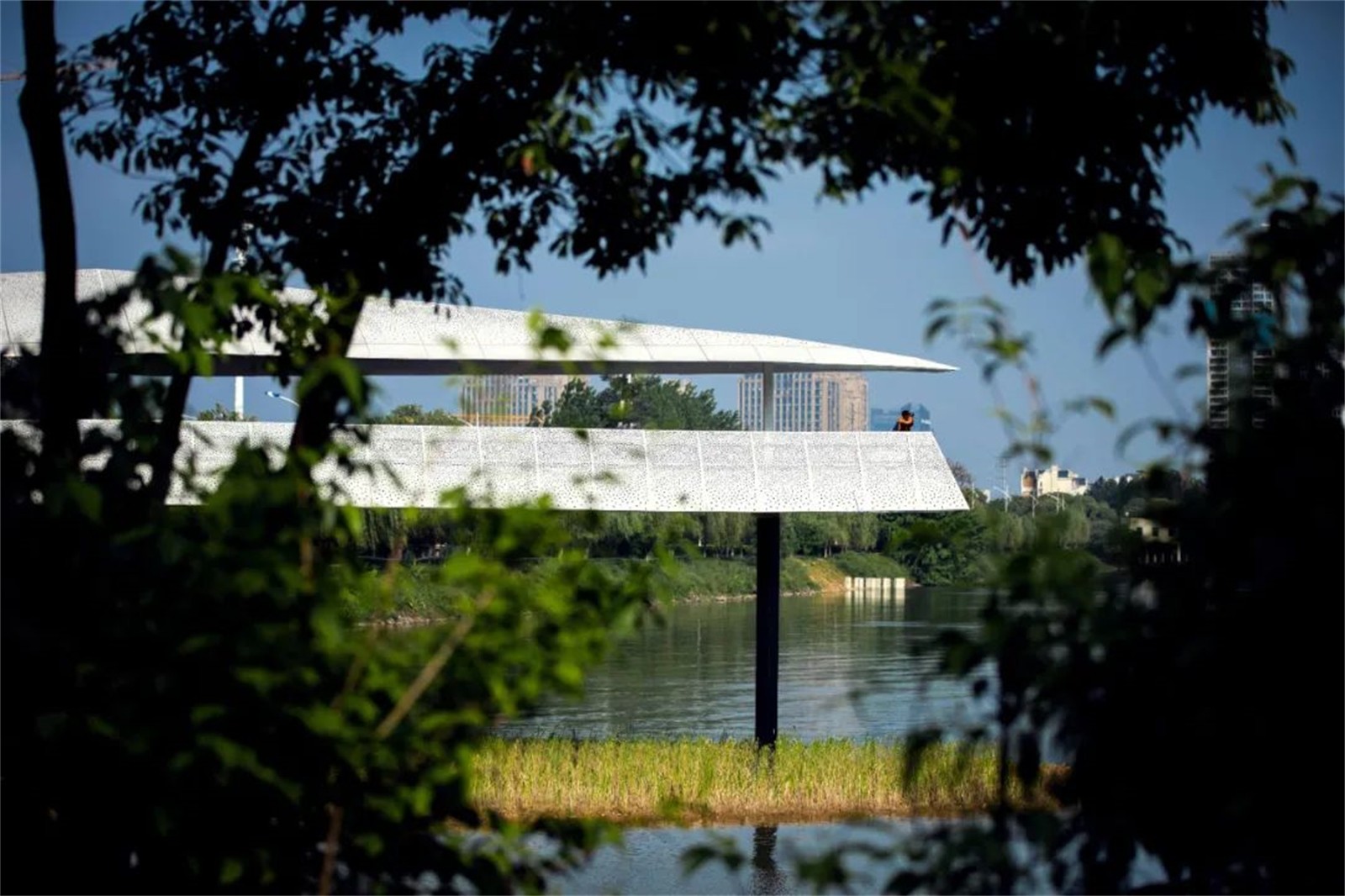
▼星水橋
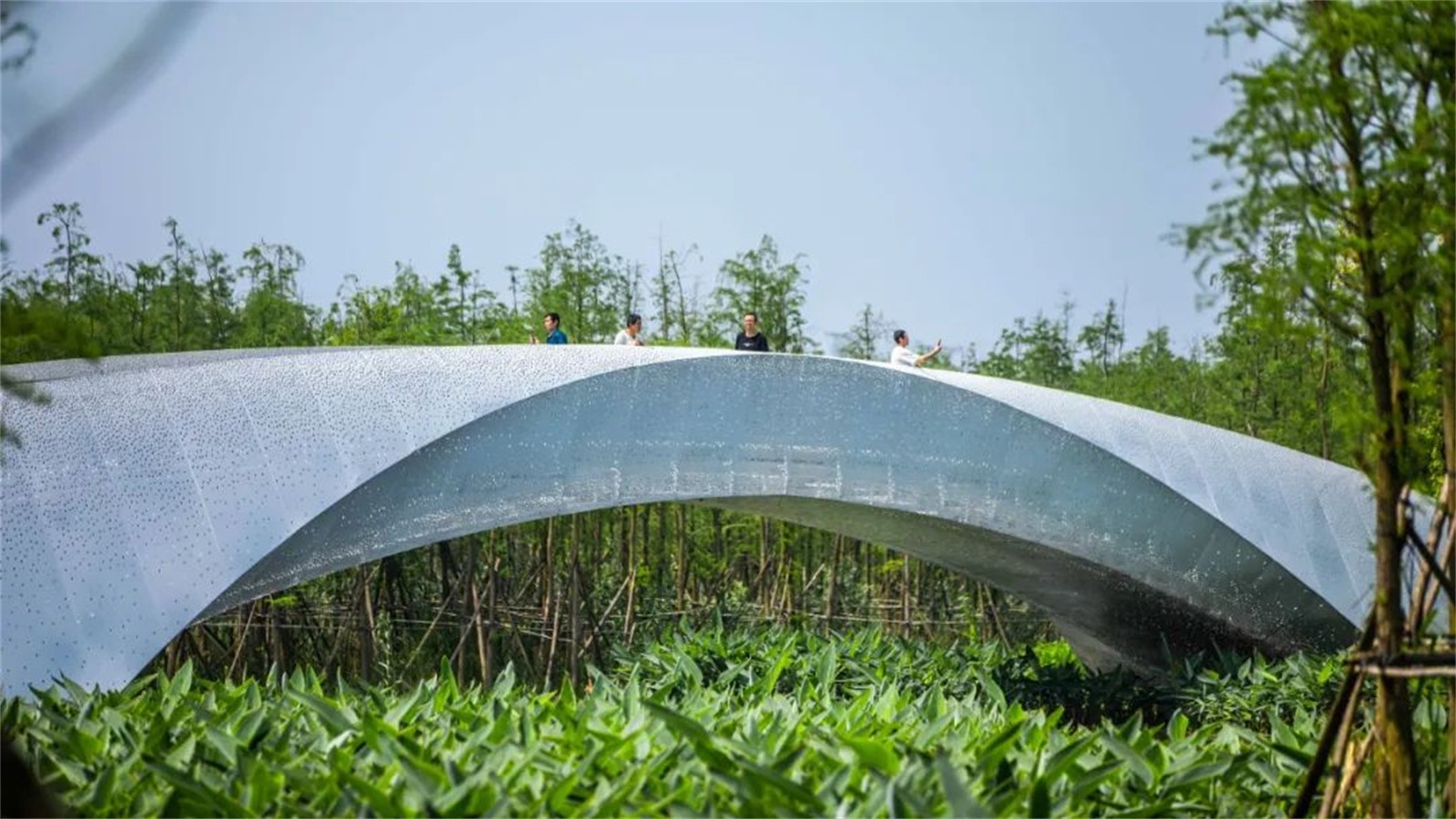
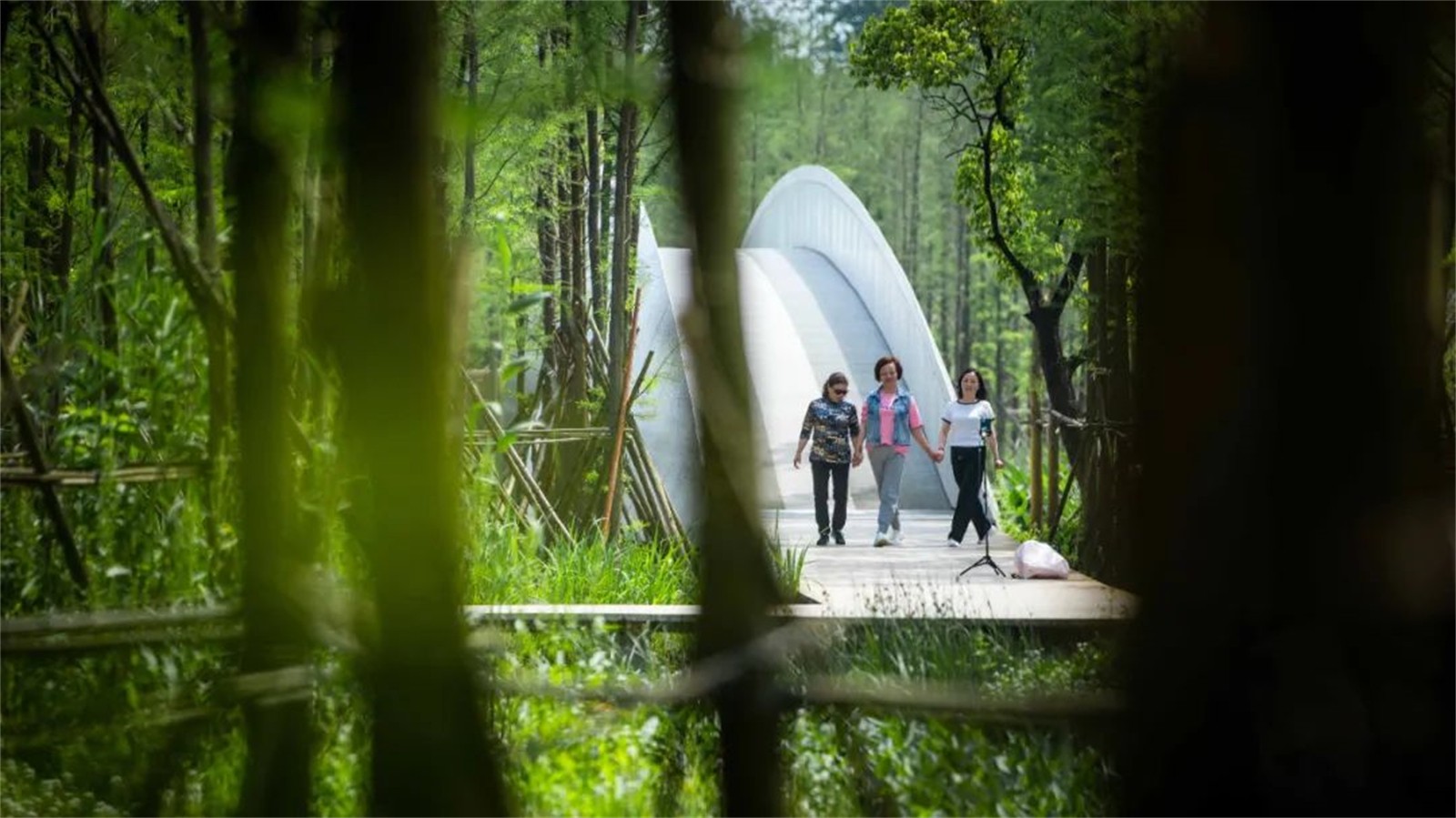
3.5現(xiàn)代設(shè)計(jì)語(yǔ)境下的空間焦點(diǎn)
Contemporary Design and Inviting Focal Points
設(shè)計(jì)師通過(guò)精心布置的橋梁、平臺(tái)���、亭臺(tái)樓閣和觀景塔��,使場(chǎng)地上形成了獨(dú)具吸引力的人氣焦點(diǎn)����。這里的現(xiàn)代設(shè)計(jì)語(yǔ)言�����,為這座2000多年的古城帶來(lái)了當(dāng)下的審美自信和進(jìn)步的氣息�。設(shè)計(jì)中,穿孔鋁板是設(shè)施安裝的主要材料���,它與自然環(huán)境形成強(qiáng)烈對(duì)比���,形成人工與自然鮮明的反差之美。在公園的主入口��,一家自助餐廳與橫跨六車(chē)道的步行橋融為一體���,將魚(yú)尾洲公園與鄰近的艾溪湖公園緊密相連�。
Bridges, platforms, pavilions and viewing towers are carefully placed to provide attractive focal points. Their contemporary design helps bring a modern taste and sense of progress to the ancient city, which dates back well over 2,000 years.. Perforated aluminum plate is the main material used for the installed structures, creating an arresting contrast with the natural setting. At the park’s main entrance, a cafeteria is integrated with an overpass across a six-lane road, connecting Fish Tail Park with the neighboring Aixi Lake Park.
▼城市與公園
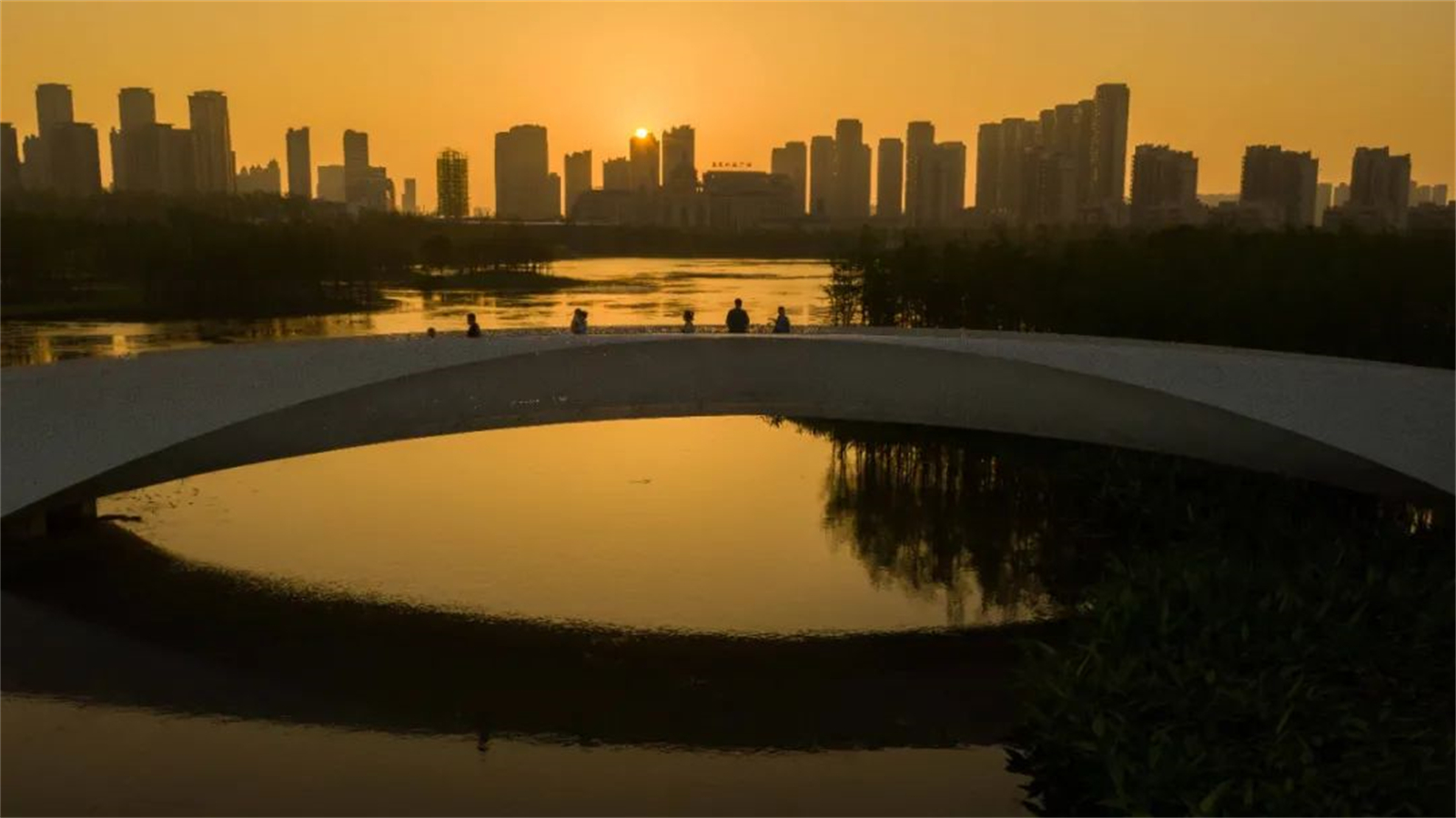
04 結(jié)論
Conclusion
事實(shí)證明,魚(yú)尾洲公園非常成功����。這片污染嚴(yán)重的城市垃圾場(chǎng)和養(yǎng)魚(yú)場(chǎng)以每平方英尺4美元(5.3美元/平方英尺<1:6.3匯率>,360元RMB/平方米)的極低預(yù)算建成���,化身成為城市中鳥(niǎo)類(lèi)和其他野生動(dòng)物的庇護(hù)所���,同時(shí)也是調(diào)蓄區(qū)域雨水的城市綠洲。獨(dú)具特色的公園環(huán)境讓她快速成為整個(gè)城市游客最多的公園之一���。國(guó)家和區(qū)域媒體廣泛報(bào)道了魚(yú)尾洲公園,這讓南昌高新區(qū)也擁有了生態(tài)文明建設(shè)的樣板���。該公園現(xiàn)在是南昌地鐵系統(tǒng)的標(biāo)志性站點(diǎn)�����,并已成為周邊地區(qū)發(fā)展的催化劑���。
Fish Tail Park has proved to be a great success. Built at an extremely modest budget of US $4 per square foot, the heavily polluted urban dumping ground and fish farm has been transformed into an urban oasis that regulates storm water, provides habitat for birds and other wildlife, and has quickly become one of the most-visited urban parks in the entire city. Regional and national media have widely reported on Fish Tail Park, which has helped give a distinct identity to Nanchang’s New District. The park is now a landmark stop on Nanchang’s subway system, and has become a catalyst for development in the surrounding area.
項(xiàng)目信息
項(xiàng)目名稱(chēng):南昌市魚(yú)尾洲公園
項(xiàng)目地點(diǎn):江西南昌
設(shè)計(jì)公司:土人設(shè)計(jì)
文字編輯:王慧嫻
排版:王慧嫻
統(tǒng)籌:賈會(huì)敏�����,田宏薇
版權(quán)聲明:本文版權(quán)歸原作者所有�����,請(qǐng)勿以景觀中國(guó)編輯版本轉(zhuǎn)載�。如有侵犯您的權(quán)益請(qǐng)及時(shí)聯(lián)系���,我們將第一時(shí)間刪除��。
投稿郵箱:info@landscape.cn
項(xiàng)目咨詢(xún):18510568018(微信同號(hào))
 京公海網(wǎng)安備 110108000058號(hào)
京公海網(wǎng)安備 110108000058號(hào)
















